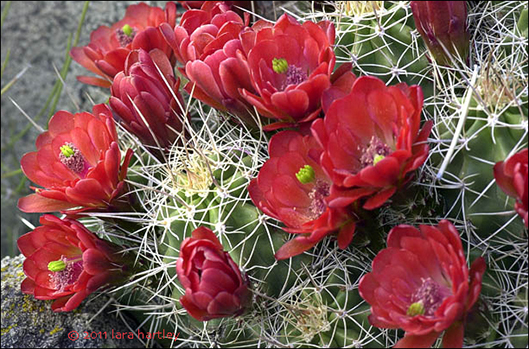Hedgehog/Claret Cup
Mojave Mound Cactus, Kingcup Cactus
Echinocereus triglochidiatus

Color: Light pink to lavender, dark rose.
Common name: Mojave Mound Cactus, Kingcup Cactus, Claret Cup Hedgehog
(e-keen-oo-KAY-ree-us tri-glow-chidi-A-tus) Echinocerens is from the Greek echinos, meaning "a hedgehog," and cereus meaning "a wax taper." These names refer to the plant's spiny resemblance to a hedgehog (or so the early Europeans thought) and the plant's shape, respectively. Triglochidialus means "three barbed bristles" and refers to the straight spines arranged in clusters of three. Also called claret cup cactus, after the reddish, cup-shaped flowers.
Latin name: Echinocereus triglochidiatus
Family: CACTACEAE
Description: A small barrel-shaped cactus. Plant generally forms from a few to hundreds of spherical to cylindrical light- to bluish green stems in more or less round, large, dense mounds. The orange to red waxy flower is funnel-shaped 8 to 9 centimeters. The plant is densely spiny and somewhat woolly. Spines fall off readily or seasonally. The fruit is juicy and edible with deciduous spines.

Range: White and Inyo Mountains, Desert
Habitat: Creosote Bush Scrub, Joshua Tree Woodland, Pinyon-Juniper Woodland. The plants grow in gravelly soils in grasslands, shrublands, pinyon/juniper, or aspen communities. The plants often grow against a rocky outcrop or within the rocky outcrop. Plants occur from three thousand and twenty to seven thousand nine hundred and fifty feet in elevation.
Elevation: 150–3000 m.
Flowering time: Apr–Jun
Notes: There is a thick nectar chamber and many thready pink stamens at the center of the corolla. The flowers are pollinated by hummingbirds. Hummingbirds are the primary pollinators and must stick their entire head into the flower to reach the nectar chambers at the flower's base. In the process, the hummingbird's forehead gets dusted with pollen. (Sometimes they look like another species of hummingbird!) The flowers stay open at night, unlike many other species of cacti whose flowers close in the evening. The flowers last three to five days.
Echinocereus triglochidiatus, a dicot, is a shrub (stem succulent) that is native to California and is also found outside of California, but is confined to western North America. Distribution outside California: to Rocky Mtns, Texas, Mexico. This plant was photographed in the Eastern Mojave National Preserve, April 26, 2003 with a Nikon D1.
Cacti have a waxy coating, thickest on the sunny side. This helps the plant minimize water loss. The spines, which help deter herbivores, also provide small amounts of shade on the cacti's surface. The shade reduces the temperature on the stem and again helps to minimize moisture loss.
To also minimize moisture loss to the atmosphere, cacti open their pores, called stomata, during the cooler hours of night to exchange oxygen and carbon dioxide. The plants photosynthesize during the day, but keep their pores closed.
Cacti can store water in the pulp of the plant's fleshy stems; it is an old tale that one can get water from a cactus. After a rain, cacti can swell like an accordion with the extra moisture. Some Native American groups collected the claret cup's stems, burned off the spines and mashed the stems. Sugar was then added to the mix and baked to form sweet cakes.
Some specimens of the claret cup lack spines.
Claret cup cacti can grow at high elevations due to the clumping of the individual stems which helps to reduce the amount of surface area exposed, thus reducing the rate at which heat is lost to the air.
We have an online wildflower field guide that is designed to help you identify desert wildflowers by color, scientific name, region and common name. The pictures are sized to work on the iPod, iPhone, iPad and similar devices. With your iPod or phone you will easily be able to identify wildflowers while in the desert. Links for downloads are on the bottom of the Wildflower Field Guide page.
Photo tips: Most digital point-and-shoot cameras have a macro function - usually symbolized by the icon of a little flower. When you turn on that function, you allow your camera to get closer to the subject, looking into a flower for example. Or getting up close and personal with a bug. More on desert photography.
Mojave Desert Wildflowers - This book is the standard by which all other wildflower books are measured. The author, Jon Mark Stewart, has combined super photography with concise information. This book has an entire color page for each wildflower covered, with a discussion of the wildflower. 210 pages with 200 color photos. More...
What's Blooming Now - Check the Wildflower Reports
Related DesertUSA Pages
- How to Turn Your Smartphone into a Survival Tool
- 26 Tips for Surviving in the Desert
- Death by GPS
- 7 Smartphone Apps to Improve Your Camping Experience
- Maps Parks and More
- Desert Survival Skills
- How to Keep Ice Cold in the Desert
- Desert Rocks, Minerals & Geology Index
- Preparing an Emergency Survival Kit
Share this page on Facebook:
The Desert Environment
The North American Deserts
Desert Geological Terms



